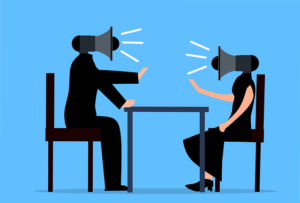Dialogue is an essential tool for any writer, but it is especially crucial in thrillers. Realism is critical when creating suspense and tension, and flow is vital to keeping the reader engaged. But dialogue can also have a strong emotional impact, adding another layer to the story. This blog post will look at some dialogue examples from thriller novels and see how they achieve these goals.
Realistic dialogue
In thrillers, realistic dialogue is key to creating a believable and tense atmosphere. By keeping the conversation short, terse, and to the point, the characters can quickly exchange information while withholding crucial details from each other. This creates a feeling of unease and distrust, which is perfect for building suspense in a thriller.
Additionally, thrillers often involve dangerous situations where people are under pressure to make quick decisions. In these circumstances, people don’t always have time for long conversations – they need to be efficient and get the job done. So thriller dialogue reflects this by being concise and to the point.
In the opening scene of her novel Gone Girl, Gillian Flynn sets the stage for a tense and suspenseful story with realistic and sharply focused dialogue. The dialogues are grounded in reality, which helps draw the reader into the story. Here is a dialogue example from an argument over dinner:
“I can’t believe you. After all these years, you go and do something like this,” he says. “You throw it all away.”
“What are you talking about?” I say.
He slams his fist on the table, rattling the silverware. “Donna told me what you did.”
Dialogue flow

Good dialogue flows smoothly and realistically in thrillers, without jarring interruptions or unrealistic pauses.
An example of an interrupted conversation would be if someone came into the room and started talking to you while in the middle of a conversation with someone else. It wouldn’t be nice to ignore the person who came into the room, so you would have to stop talking to the person you were originally speaking with.
Here is a sample of an unrealistic pause:
“I can’t believe you,” he said, interrupting me. “After all these years, you go and do something like this.”
“You throw it all away,” he continued, pausing for a few seconds.
Here is a sample of a jarring interruption:
She turned to face him, her eyes widening in surprise. “I didn’t think you’d actually show up.”
“You sounded pretty desperate on the phone.” He stepped closer, his hand outstretched. “Let me help you.”
She hesitated for a moment before lowering her guard and placing her hand in his. “Thank you.”
He pulled her close, using his other hand to cover her mouth. “Don’t thank me yet,” he whispered into her ear.
Emotional impact

Well-written dialogue can have a powerful emotional impact on readers. It’s important to be aware of the emotional context in conversation as it can help you better understand what someone is saying. For example, if someone is angry, they might not be as likely to listen to your point of view.
Being aware of the emotional context in dialogue also allows you to better gauge the other person’s reaction to what you’re saying. This awareness can be beneficial when trying to persuade or convince someone of something. You can adapt your argument accordingly if you know how they’re likely to react.
When dialogue flows well, it emotionally impacts readers, making them feel more engaged with the story. This dialogue example from The Catcher in the Rye is an excellent example of dynamic conversation:
“Don’t ever tell anybody anything. If you do, you start missing the things that matter.”
“That’s just the way I am,” he said. “I mean, if somebody wants to sit on a bench in a park and just want to be alone, they should be allowed to without people coming and asking them what they’re doing.”
You can use dialogue to create a sense of realism in a story. In the following example, two characters are discussing an upcoming test:
“I’m not sure I’m ready for this,” Sarah said, biting her lip.
“You’ll be fine,” Tom replied.
This dialogue is realistic because it naturally portrays the characters’ thoughts and feelings. It also has a strong emotional impact, making readers feel more engaged with the story. When you write dialogue that flows well, it can create an immersive reading.
This excerpt from Gone Girl is an example of honest dialogue:
“What are you doing?” he asked, his voice low and husky. I could feel his eyes on me, even in the darkness.
Examples of effective dialogue in thrillers

It’s essential to note that dialogue should never slow down the pacing of your story. On the contrary, for dialogue to be effective, it must move the plot forward and create a sense of tension.
Dialogue can be one of the most effective ways to create suspense and keep readers engaged in a thriller. By interspersing brief, intense exchanges between characters, you can ratchet up the tension while also providing clues and insights into the plot.
Here are a few examples of effective dialogue in a thriller:
“I’ve got a gun.”
“You don’t know who you’re dealing with.”
“What have you done?”
“It’s not over yet.”
Examples of effective dialogue between 2 and more people:
“I think he’s following us.”
“What makes you say that?”
“I don’t know. . . It just feels like he’s there.”
“You’re being paranoid.”
“I’m not being paranoid. I’m just saying that it feels like he’s there.”
“Well, what do you want me to do about it?”
“I don’t know. . . Maybe we could lose him.”
A: “I’m not sure what to make of that new study. Do you think it’s legit?”
B: “It definitely has some interesting implications, but I think we need to wait for more research to come out before we jump to any conclusions.
A: “I can’t believe she got promoted over me!”
B: “Well, she’s been with the company longer and is a lot more qualified.”
C: “I know it’s not fair, but sometimes these things happen.”
D: “Maybe there’s something you can do to improve your qualifications and get promoted next time.”
Here is an example of ineffective dialogue from The Girl on the Train:
Rachel: “I think about you all the time,” I can’t help it. It’s like you’re this bright light that I can’t look away from. And when I’m with him, I’m thinking of you.”
Tom (interrupting): “Rachel, stop it! You have to stop this right now!”
Rachel: “No, I don’t have to do anything! You’re the one who has to stop this! You’re the one who has to let me go!”
Tips for writing effective dialogue
Do you know your characters? This is a valid question, and it underscores the importance of getting to know your characters inside and out. The more you know them, the easier it will be to write authentic dialogue that rings true for them.
One great way to get to know your characters better is by studying people. Observe how they interact with others, what they say and how they say it, and pay attention to their body language.
By observing people closely, you’ll begin to understand what makes them unique – and that’s essential for creating believable dialogue. So any time you have a chance, write it down.
To create realistic, emotionally charged dialogue, you should consider the following questions:
– Who is speaking? Make sure each character has a unique voice.
– What are they saying? Be sure that dialogue advances the plot and provides insights into character motivation.
– Why are they saying that? Be sure to know the emotional reason behind each dialogue exchange.
– How are they saying it? Dialogue should be realistic and sound like something people would actually say.
It’s important to keep the dialogue flowing smoothly when considering all these elements. It will help create an immersive reading experience and maintain readers’ attention throughout the story.
Dialogue can be your best friend or your worst enemy. Too much of it, and your readers will lose focus; too little, and they may feel like they’re not getting the whole story. So striking the right balance is critical.
In general, use dialogue to advance the plot, reveal character, or create a sense of intimacy with the reader. But avoid using it for exposition (telling), description, or simple conversation.
A few things to consider are the big differences between direct and indirect dialogue. Indirect dialogue is the voice in your head that talks to you on a regular basis. Some people call it their “inner monologue.”
With direct dialogue, the speaker says exactly what is on their mind, while with indirect dialogue, the speaker doesn’t say everything that’s on their mind. They might sugarcoat it, or they might not say it at all.
There are pros and cons to both forms of dialogue. With direct dialogue, you get immediate clarity, while with indirect dialogue, you might have to guess what the person is trying to say. However, there is a greater chance of misunderstanding with indirect dialogue because the speaker can be unclear.
Most of the time, indirect dialogue is just chatter – meaningless noise you don’t need to pay attention to. But sometimes, your inner dialogue can be helpful. It can give you guidance and support when you need it.
Formatting dialogue examples

In a conversation, proper dialogue formatting is important because the formatting can help create interesting, complex characters, which will give you a chance to show part of the action rather than having to tell the whole story.
Good dialogue sounds natural and flows smoothly, while bad dialogue can sound forced or artificial. Certain formatting can make your dialogue sound better.
Let’s use the sample conversation below to demonstrate the different formatting in dialogue:
“Good morning, everyone.”
“We’ll be kayaking part of the Cariboo River this morning,” Bev said. “The river is about a hundred meters wide, so you’ll have room to move around and enjoy the experience.”
Lucy’s eyes widened. “What do you mean ‘the experience’?”
“Once we get to the open river, things start to move faster and—”
“How fast are we talking?” Cathy interrupted, pushing her glasses up.
“About the same speed as when you’re paddling hard. There will be some ripples—”
“Ripples?” Lucy cut in, looking toward the chute. I don’t know. . .”
Example 1
“Good morning, everyone.”
Enclose spoken words with double quotation marks.
Example 2
“We’ll be kayaking part of the Cariboo River this morning,” Bev said. “The river is about a hundred meters wide, so you’ll have room to move around and enjoy the experience.”
The above example shows the dialogue tag (Bev said) outside the quotation marks, and the punctuation (comma) stays inside the quotation marks.
When a dialogue tag comes before the dialogue, for example, Bev said, “We’ll be kayaking part of the Cariboo River this morning,” the first comma comes before the first quotation mark.
Example 3
Lucy’s eyes widened. “What do you mean ‘the experience’?”
The above example shows quoting within the dialogue. In this sample, single quotation marks enclose ‘the experience’ to show that Lucy is quoting Bev. The last single quotation mark comes before the punctuation (question mark).
Text coming after a quote, for example, “What does ‘the experience’ have to do with it?” she said. When you add a tag, in this case, she said, after a question mark (or exclamation mark), the first letter of the tag should be in lower case.
Also, in the sample above, it’s unnecessary to add the tag, Lucy said, as we already know that she is reacting to Bev’s comment with widened eyes.
Example 4
“Once we get to the open river, things start to move faster and—”
“How fast are we talking?” Cathy interrupted, pushing her glasses up.
The first line ends with an em dash, indicating that the dialogue was interrupted. You should place Em dashes inside the final quotation marks.
Example 5
“Don’t worry,” Bev patted her shoulder, “ripples are like tiny waves ruffling the surface of the water.”
In the above line, action interrupts dialogue. When that happens, the first letter of the second fragment should be in lower case.
Example 6
“Ripples!” Lucy looked toward the chute. “I don’t know. . .”
In the line above, the exclamation point and looking toward the chute shows Lucy’s apprehension. The ellipse trailing off of the dialogue shows her hesitation. When you end a conversation with an ellipse, no additional punctuation before the quotation mark is needed.
Example 7
Quotation marks are treated differently in a long story. Here is a sample story to demonstrate:
“Seppo was almost fifteen when two police officers knocked on his door. His adoptive parents had died in a car accident. One of the officers stayed behind and talked to him, giving him some fatherly advice. Soon after, Seppo applied for a passport, packed a bag, and hitchhiked through Sweden to Gothenburg. There, he approached the captain of a Canadian merchant ship heading for Halifax. He lied about his age, bragged about being a hard worker, and asked if he could come along and work for food.
“When they arrived in Halifax, he took off and hitchhiked across Canada. He hitched a ride with a retired police detective from North Vancouver one day. Seppo told him his story and how he wanted to be a policeman because everyone who’d been nice to him had been a policeman. So the man helped him enroll into law enforcement training in Vancouver, and here we are.”
When someone speaks for an extended period, it’s easier for the reader to grasp the story if you break it up into two or more paragraphs. In the story above, the opening quotation mark is placed at the beginning of the first paragraph as usual.
When you make a new paragraph, you don’t add a quotation mark at the end of the first paragraph. Instead, start the second paragraph with a quotation mark and add a closing quotation mark at the end of the story.
Conclusion
Dialogue is one of the most important tools a thriller writer has to create a believable and tense atmosphere. By writing realistic, smooth dialogue that flows naturally, you can immerse your readers in the story and keep them engaged until the end.
Thank you for following along with our examples of effective dialogue in thrillers.
If you’re working on your first novel and are looking for more help with your writing, please check out my other articles at https://ullahakanson.com/blog/
Best of luck with your writing!
Ulla

